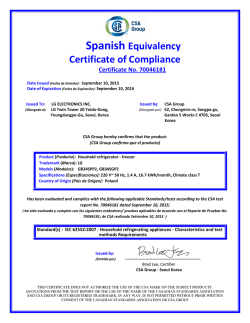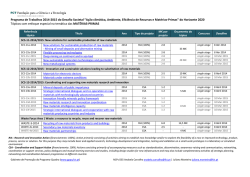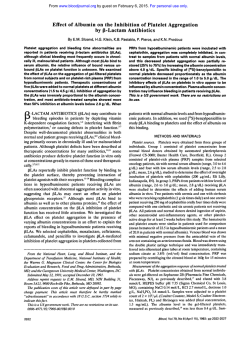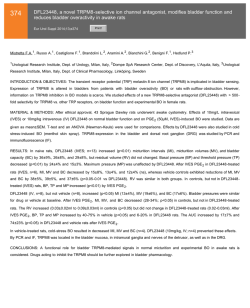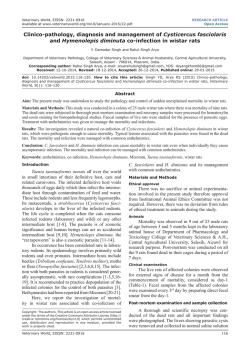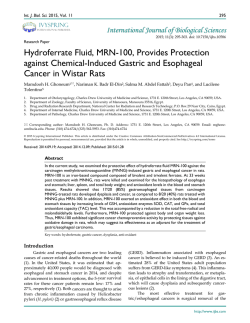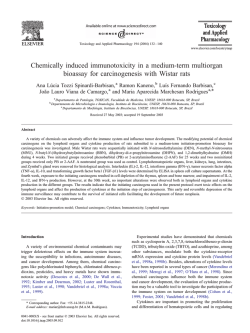
CsA - Radboud Repository
PDF hosted at the Radboud Repository of the Radboud University Nijmegen The following full text is a publisher's version. For additional information about this publication click this link. http://hdl.handle.net/2066/25145 Please be advised that this information was generated on 2015-02-06 and may be subject to change. O rig in a l P a p e r NEPHRON Nephron 1 997;75:336-341 .ƒ.F. A n tip r o te in u r ic E ffe c t o f Desassis C.J.I. Raals MA.H. Bakker J. van den Bom J.H.M. Berden Accepted: March 5,1996 C ic lo s p o r in A in A d r ia m y c in N e p h r o p a t h y in R a t s Division of Nephrology, St. Radboud U niversity Hospital, Nijmegen, The Netherlands Key Words Abstract Adriamycin nephropathy Albuminuria Ciclosporin, antiproteinuric effect Ciclosporin A (CsA) can reduce proteinuria in various forms of human and experimental glomerulopathies. This antiproteinuric effect can be the result of a decrease of immunological damage, a decrease in the glomerular filtration rate (GFR), or a change in the permselective properties of the glomerular cap illary wall. In this study we investigated the effect of CsA on Adriamycininduced nephropathy in rats. A single intravenous injection of Adriamycin (5 mg/kg body weight) induced a severe nephrotic syndrome with a massive albuminuria (± 400 mg/24 h from 3 weeks onwards) and a hypoalbuminemia ( ± 7 mg/ml after 5 weeks). The IgG/albumin selectivity index was 0.16 ± 0.05, indicating a preferential loss of albumin. A 5-day treatment with CsA reduced the albumin excretion by almost 50% (from 336 ± 91 to 178 ± 58 mg/24 h; p = 0.002) and induced an increase in the serum albumin level (from 7,1 ± 4.1 to 12.8 ± 3.2 mg/ml; p = 0.002) in contrast to the vehicle olive oil (OO). CsA also decreased the GFR by 40% (from 0.74 ± 0.11 to 0.41 ±0.11 mg/ml/100 g body weight; p = 0.002). Albuminuria corrected for the GFR (fractional excretion of albumin, FEaib) was still significantly lower in CsAtreated than in OO-treated animals (FEaib CsA: 1.35 ± 0.88, FEaib OO: 3.17 ± 2.29%; p = 0.0005). This suggests that other factors are also involved in the reduction of albuminuria. To exclude that CsA has an effect on the tubular reabsorption of albumin, we evaluated the blockade of the tubular reabsorp tion by lysine and found no difference in albuminuria between the CsA- and OO-treated groups. These experiments suggest that the antiproteinuric effect of CsA is not (only) due to a decrease in the GFR, but also to a decrease of the enhanced permeability of the glomerular capillary wall for albumin. » Introduction The antiproteinuric effect o f ciclosporin A (CsA) has been described in several studies, both in patients with various glomerular diseases and in experimental animal KARG EK © 1997 S. Karger AG, Basel 0028-2766/97/0753-0336$ 12.00/0 E-Mail [email protected] F a x + 41 61 306 12 34 h ttp: //www. ka rger. ch This article is also accessible online at: http:// BioM edNet.com/karger models [1, 2]. As CsA is a potent immunosuppressive drug, it is possible that this antiproteinuric effect is due to inhibition of the glomerular inflammatory process. How ever, although the immunosuppressive effect might con tribute to the observed antiproteinuric effect, there are C.J.I. Raats, MD Division of Nephrology St. Radboud University Hospital PO Box 9101 NL-6500 HB Nijmegen (The Netherlands) several arguments which indicate that other mechanisms are also involved, since CsA is also effective in nonimmune glomerular diseases like Alport syndrome [3]. The antiproteinuric effect of CsA could be due to the druginduced reduction of the glomerular filtration rate (GFR), which leads to a decrease of the filtered load of protein. If this mechanism is responsible, the fractional excretion of albumin (FEaib) should be identical before and after treat ment. However, as we [4, 5] and others [3, 6] have shown, the FEaib was significantly lower during CsA treatment, which suggests that the reduction in GFR is not solely responsible for the observed antiproteinuric effect. Fur thermore, in patients with focal glomerulosclerosis and membranoproliferative glomerulonephritis, CsA induced a significant drop in GFR and effective renal plasma flow, but had no effect on proteinuria [6]. This discrepancy between the hemodynamic and antiproteinuric effects of CsA raises the possibility that CsA may influence the permselective properties of the glomerular capillary wall (GCW). Recently, we did indeed find in a passive model of murine anti-glomerular basement membrane nephritis that CsA still had an antiproteinuric effect after pharma cological prevention with phenoxybenzamine of the CsAinduced drop of the GFR [4]. This study underlines that the antiproteinuric effect of CsA might be due to mecha nisms other than GFR reduction. The results of in vitro glomerular permeability studies also show an effect of CsA. Isolated glomeruli of animals treated with CsA for 2-3 weeks [7] or glomeruli exposed to CsA in vitro [8] displayed in vitro a significantly lower ultrafiltration coef ficient Kf and a lower hydraulic conductivity Lp than con trol glomeruli. Theoretically, CsA could increase the tubu lar reabsorption of albumin, although this explanation is not very likely in the face of the known tubulotoxic effects of CsA. One of the most widely accepted indications for CsA treatment in the nephrotic syndrome is minimal change disease (MCD). Proteinuria decreases after the introduc tion of CsA in the majority of patients with MCD [9-12]. It has been argued that CsA may be effective in MCD by inhibiting the production of certain cytokines [9] or circu lating cations [13] which are thought to be responsible for disturbing the charge-selective permeability of the GCW. We decided to study the antiproteinuric effect of CsA in Adriamycin nephropathy (ADR-NP). Because of the dis appearance of the glomerular polyanion, ADR-NP is, although not uniformly, regarded as an experimental model of MCD [14,15]. A second argument to study CsA in ADR-NP is that this experimental model has a nonimmunological genesis. This circumvents possible effects of CsA on the evolution of the nephrotic syndrome. In this model we investigated in animals with a heavy and stable proteinuria the antiproteinuric effect of CsA, and we cor related this with the CsA-induced changes in GFR. To exclude the possibility that CsA influences the tubular reabsorption of albumin, we analyzed the effect of intra venously administered lysine on the albumin excretion in CsA-treated and control rats. Ciclosporin in Adriamycin Nephropathy Nephron 1997;75:336-341 Materials and Methods Animals For all experiments we used male Wistar rats that were bred in our animal laboratory and weighed ± 200 g at the start of the experi ments. The animals were fed standard food and tap water ad libi tum. Adriamycin Nephropathy Adriamycin® (Adriablastina; Farmitalia, Milan, Italy) was ad ministered as a single intravenous injection via the tail vein under ether anesthesia. In an initial experiment, the optimal dose of ADR was determined. To this end, either 2.5, 5, or 7.5 mg ADR/kg body weight (BW) was injected into 5 rats/group. This experiment re vealed that with 5 or 7,5 mg ADR/kg BW a stable albuminuria was achieved 3 weeks after the injection, whereas after 2,5 mg/kg the ensuing albuminuria was less severe and still increasing after 3 weeks. Since a dose of 5 mg/kg was not associated with any direct morbidity or mortality, in contrast to the 7.5 mg/kg dose, the 5 mg/kg dose was adopted for all further experiments. Urine and serum samples were collected every week for 5 weeks to determine albumin and IgG concentrations. Urinary protein excretion was measured in urine collected for 24 h in metabolic cages. Urine and serum concentrations of albumin were determined by rocket immunoelectrophoresis [16], with goat anti-rat albumin and rat albumin as a standard (both from Nordic, Tilburg, The Neth erlands). Urine and serum IgG concentrations were determined by means of a capture ELISA as previously described [17]. From these data, the albumin clearance and the FEaib (clearance of albumin/ GFR) were calculated with standard formulas. The selectivity index of the proteinuria was calculated as clearance IgG/clearance albu min. CsA Treatment To assess the antiproteinuric effect of CsA (Sandoz Nederland, Uden, The Netherlands), rats injected with 5 mg/kg BW ADR on day 0 received either CsA (n = 10) or the solvent olive oil ( 0 0 ; n = 10). CsA was orally administered once daily at a dose of 20 mg/kg BW in 0.5 ml OO. On day 28, 24-hour urine was collected, a serum sample was drawn, and the GFR (see below) was measured on day 29. There after, CsA or OO treatment was started on day 30. During CsA treat ment, urinary protein excretion was determined on day 34 and GFR on day 35. At the end of the experiment, the animals were sacri ficed. G FR was measured by the single-shot 51Cr-EDTA technique. In brief, after an intravenous injection of 10 jiCi 51Cr-EDTA (Amersham, UK), a single timed (60 min) blood sample was obtained from the retro-orbital plexus under ether anesthesia. A calibrated 200-jil 337 0 Fig. 1. Serum albumin and albuminuria over time in rats after a single intravenous injection o f 5 mg ADR/kg BW, O = Serum albu min; • = urinary albumin excretion. plasma sample was counted in a gamma scintillation counter. GFR was calculated according to the formula: GFR = (V/t)*ln(P0/Pt), where V is the distribution volume of 51Cr-EDTA (ml) and PO, Pt the plasma concentration of 51Cr-EDTA at time zero and t min (cpm/ ml). Pt is derived from the plasma sample at t = 60 min; PO is calcu lated from PO = I/V, where I is the injected amount of 5lCr-EDTA (cpm), and V is calculated from the formula established by Provoost at al. [18]: Y = (0.264-BW) - (1.92• 10-4 BW 2) + it03i To evaluate the effect of CsA on the tubular reabsorption of albu min, the effect o f an intravenous bolus injection of lysine was investi gated in a different group of animals. To this end, CsA or OO treat ment (n = 10 for each group) was started on day 30 after injection of ADR and continued daily until the end of the experiment (day 36). On day 34 GFR was measured. On day 35 urinary albumin excretion was measured during 2 h, thereafter the animals received 600 mg/ 100 gBW lysine, and urinary albumin excretion was measured again for 2 h. To evaluate the effect of lysine on GFR, the next day the same dose of lysine and immediately thereafter 5,Cr-EDTA were administered to measure GFR. Statistics The Mann-Whitney U test was used for intergroup comparisons, and the Wilcoxon signed-rank test was used for intragroup compari sons. p < 5 % was considered significant. Results Characteristics o f A D R -N P After an intravenous injection of 5 mg/kg BW ADR, a progressive albuminuria developed from 7 days onwards after the injection. At 3 weeks, this urinary albumin excre tion stabilized at around 400 mg/24 h and thereafter remained at that level (fig. 1). Concomitant with the increase in urinary albumin excretion, there was a severe 338 N ephron 1997;75:336-341 1 2 3 4 5 Time after ADR injection (weeks) drop in serum albumin levels, reaching 5-7 mg/ml at 5 weeks. Despite this severe decrease in serum albumin concentration, there was an increasing clearance of albu min. To investigate whether this proteinuria was se lective, we calculated the selectivity index of the protein uria (clearance of IgG/clearance of albumin) at week 4. This revealed a selectivity index of 0.16 ± 0.05(95%confidence interval 0.14-0.18), indicating a preferential uri nary loss of albumin. Antiproteinuric Effects o f CsA Treatment with CsA in the ADR model resulted in a significant decrease of albuminuria and an increase of serum albumin, in contrast to the OO-treated controls, in which these two parameters did not change (table 1). As expected, the GFR also decreased significantly in the CsA-treated animals, whereas in the OO-treated group the GFR remained stable. However, the increase in serum albumin together with the reduction in GFR cannot explain the reduction in albuminuria. When we calcu lated the albuminuria corrected for serum albumin and GFR (FEaib), we still observed a significant decrease in the CsA-treated animals, whereas this parameter did not change in the OO-treated controls (table 1). If the GFR reduction was not (solely) responsible for the decrease in albuminuria, theoretically two other major mechanisms could be responsible for the antialbuminuric effect. CsA could either decrease the enhanced permeability of the GCW for proteins or increase the tubular reabsorption of albumin. Although this enhanced tubular reabsorption is unlikely in view of the known tubulotoxic effect of CsA, Desassis/Raats/Bakker/van den Bom/ Berden T able 1 - Effect of CsA or OO on albuminuria, serum albumin, GFR, and FEaib in rats with ADR-NP CsA Albuminuria, mg/24 h Serum albumin, mg/ml GFR, ml/min/lOOgBW FEaib, % OO before after P before after P 336±91 7.1 ±4.1 0.74 ± 0,11 2.43+1.26 178±58 12.8 ± 3.2 0 .4 1 ± 0 .1 1 1.35 + 0.88 0.002 0.002 0.002 0.002 389 ± 123 5.5±2.1 0 . 7 0 ± 0 . 12 4 .0 6 ± 3.29 311 ± 4 6 5.6± 2.7 0.73±0.12 3.17±2.29 NS NS NS NS NS = Not significant. we wanted to formally exclude this possibility. Therefore, we investigated whether the effect of blockade of the tubu lar albumin reabsorption by lysine differed between the two groups. We found no significant difference in the absolute amount of urinary albumin excretion before and after lysine infusion in both groups (table 2). However, lysine induced both in the CsA- and the OO-treated ani mals a significant decrease in the GFR and thereby in the filtered load of albumin. This lysine-induced decrease in GFR was also seen in control rats (table 2). Therefore, we calculated the ratio between the 2-hour excretion of albumin/GFR before and after lysine administration, assum ing that the serum albumin concentration did not change during this short observation period. In CsA-treated ani mals, this ratio was 1.5 ± 0.6 and in the OO-treated rats 1.8 ± 0.9. From these ratios it is clear that lysine induced in both groups a significant increase of the FEaib due to a blockade of tubular albumin reabsorption. This increase in the FEaib was not statistically different between the two groups (p = 0.6). Table 2. Effect of lysine on albuminuria, GFR, and albuminuria/ GFR ratio in ADR-NP in rats treated with either CsA or OO Lysine CsA Albuminuria, mg/2 h GFR, ml/min Albuminuria/GFR ratio Albumin uria/GFR ratio after/before lysine OO Albuminuria, mg/2 h GFR, ml/min Albuminuria/GFR ratio Albuminuria/GFR ratio after/before lysine Control rats GFR, ml/min before after P 1 i.2 ± 3 .9 0.89 ± 0 ,2 0 13.3 + 4.9 11.3 + 3.0 0.64+0.20 20.0±3.8 NS 0.012 0.03 1.5±0,6 15.9 + 7.1 1.44±0.35 1L5 + 5.0 19.9 ± 5.3 1.22 + 0.28 17.0±4.7 1.8±0.9 2.14 + 0.16 1.94 + 0.05 NS 0.008 0.06 ~ a 0.012 NS - Not significant. 11 The ratio between CsA and OO is not significantly different. Discussion In this study, we investigated the effect of CsA on ADR-NP which is regarded as a model for human MCD. The injection of 5 mg ADR/kg BW in rats induced a severe nephrotic syndrome with a massive albuminuria and an evident hypalbuminemia which was also found in previous studies [14, 15]. In the literature several contra dictory mechanisms have been proposed for the induction of this ADR-associated nephrotic syndrome, either a de crease in the charge-dependent permeability [14, 19, 20] or an increase of the size-dependent permeability of the GCW [ 15,21 ] or a combination of both mechanisms [22]. In our study, we found a rather selective proteinuria which is more in line with a charge-dependent alteration. This is corroborated by our finding that the heparan sul fate staining of the glomerular basement membrane de creases by 60% over a period of 4 weeks, as we described previously [23]. With different but less specific ap proaches, a reduced glomerular polyanion has been found in ADR-NP before. In the first detailed description of ADR-NP [14], it was already reported that with the use of colloidal iron the glomerular polyanion disappeared quickly and was totally absent for at least 4 weeks. With polyethyleneimine as a probe, a 25% reduction in the number of heparan sulfate-associated sites was found in Ciclosporin in Adriamycin Nephropathy Nephron 1997;75:336-341 339 the lamina rara externa of rats with ADR-NP [24], and with cationic colloidal gold a 60% reduction of anionic sites in the GBM of rats with ADR-NP was observed [25]. Benjelloun et al. [26] found a reduced number of total glycosaminoglycans in the glomeruli and an increased uri nary excretion of both total glycosaminoglycans and of heparan sulfate. Since heparan sulfate is not only a deter minant for the charge-dependent permeability, but also for the size-dependent permeability [27], these alterations might explain the existing discrepancies with regard to the pathophysiology of proteinuria in ADR-NP. To investi gate whether other mechanism than the GFR reduction were responsible for the antiproteinuric effect of CsA, we evaluated the effect o f blockade of the tubular albumin reabsorption by lysine. We found a similar change in albu minuria after lysine treatment between the CsA- and 0 0 treated groups. Although the GFR decreased, there was no difference in the ratio of the 2-hour excretion of albu min before and after treatment with lysine between the CsA- and OO-treated groups. Therefore, we were able to exclude that CsA has its effect through a change in tubular reabsorption of albumin. These experiments suggest that the antiproteinuric ef fect of CsA is not (only) due to a decrease in the GFR, but also to a decrease of the enhanced permeability of the GCW for proteins. How can one envision this effect of CsA on the glomerular permeability? It is known that ADR can induce the formation of reactive oxygen species [28]. Indeed, in ADR-NP, the glomerular cells produce reactive oxygen species which cause glomerular injury, leading to proteinuria [29]. Also in other experimental models, such as Heymann nephritis and puromycin aminonucleoside-induced nephrosis, it is established that the proteinuria critically depends on the formation of reac tive oxygen species [30-32]. The normalization of the glo merular permeability might be due to the fact that CsA is able to inhibit formation of reactive oxygen species [33]. In conclusion, our study suggests that the antiprotein uric effect of CsA in ADR-NP is due to both a decrease in GFR and a reduction of the enhanced permeability of the GCW for albumin. Acknowledgements Dr. J.F. Desassis was supported by a grant through the EU Science Program (Grant B/SC1-915107). This study was further sup ported by grants from the Dutch Kidney Foundation (Grant C93.1318) and from the EC Biomed I program (Grant BMH1-CT921766). The expert technical assistance of Mr. Jan Koedam and his coworkers of the Central Animal Laboratory is gratefully acknowl edged. CsA was a generous gift of Sandoz Nederland BV, Uden, The Netherlands. References 1 Meyrier A: Antiproteinuric and immunological effects of cyciosporine A in the treatment o f glomerular diseases. Nephrol Dial Transplant I992;7(suppl l):80-84. 2 Meyrier A: Use of cyclosporin in the treatment of idiopathic nephrotic syndrome in adults; in Tejani A (ed): Cyclosporin in the Therapy of Renal Disease. Contrib Nephrol. Basel, Karger, 1995, vol 114, pp 28-48. 3 Zietse R, Wenting GJ, Kramer P, Mulder P, Schalekamp MA, Weimar W: Contrasting re sponse to cyclosporin in refractory nephrotic syndrome. Clin Nephrol 1989;31:22-25. 4 Schrijver G, Wetzels JFM, Robben JCM, Assmann KJM, Koene RAP, Bcrden JHM: Anti proteinuric effect of cyciosporine A in passive antiglomerular basement membrane nephritis in the mouse. Transplant Proc 1989;20(suppl 3):304-308. 5 Schrijver G, Assmann KJM, Wetzels JFM, Berden JHM: Ciclosporin A reduces albumin uria in experimental anti-GBM nephritis inde pendently from changes in GFR. Nephrol Dial Transplant 1995; 10; 1149-1154. 340 Nephron 1997;75:336-341 6 Zietse R, Wenting GJ, Kramer P, Schalekamp MADH, Weimar W: Effects of cyclosporin A on glomerular barrier function in the nephrotic syndrome. Clin Sci 1992;82:641-650. 7 Jameson MD, Savin YJ, Sharma R, Lovell HB, Diederich DA: Ciclosporine treatment de creases glomerular ultrafiltration coefficient (abstract). Clin Res 1989;37:951. 8 Wiegmann TB, Sharma R, Diederich DA, Sa vin VJ; In vitro effects of cyciosporine on glo merular function. Am J Med Sci 1990;299: 149-152. 9 Tejani A, Butt K, Trachtman H, Suth anti ran M, Rosenthal C, Khawar M: Ciclosporin A induced remission of relapsing nephrotic syn drome in children. Kidney Int 1988;33:729— 734. 10 Ponticelli C, Rizzoni G, Edefonti A, Altieri P, Rivolta E, Rinaldi S, Ghio L, Lusvarghi E, Gusmano R, Locatelli F, Pasquali S, Castellani A, Della Casa-Alberighi O: A randomized trial of cyciosporine in steroid-resistant idiopathic nephrotic syndrome. Kidney Int 1993;43: 1377-1384. 11 Melocoton TL, Kamil ES, Cohen AH, Fine RN: Long-term cyciosporine A treatment of steroid-resistant and steroid-dependent ne phrotic syndrome. Am J Kidney Dis 1991; 18: 583-588. 12 Meyrier A, Noel LH, Auriche P, Callard P: Long-term tolerance of cylcosporin A treat ment in adult idiopathic nephrotic syndrome. Kidney Int 1994;45:1446-1456. 13 Levine M, Gascoine P, Turner MW, Barratt TM: A highly cationic protein in plasma and urine of children with steroid-responsive ne phrotic syndrome. Kidney Int 1989;36:867877. 14 Bertani T, Poggi A, Pozzoni R, Delaini F, Sacchi G, Thoua Y, Mecca G, Remuzzi G, Donati MB: Adriamycin-induced nephrotic syndrome in rats. Lab Invest 1982;46:16-23. 15 Weening JJ, Rennke HG: Glomerular perme ability and polyanion in Adriamycin nephrosis in the rat. Kidney Int 1983;24:152-159. 16 Laurell CB: Quantitative estimation of pro teins by electrophoresis in agarose gel contain ing antibodies. Anal Biochem 1966; 15:45-52. Desassis/Raats/Bakker/van den Born/ Berden 17 Van den Born J, Van den Heuvel LPWJ, Bakker MAH, Veerkamp JH, Assmann KJM, Berden JHM: A monoclonal antibody against GBM heparan sulfate induces an acute se lective proteinuria in rats. Kidney Int 1992;41: 115-123. 18 Provoost AP, De Keijzer MH, Wolff ED, Molenaar JC: Development of renal function in the rat. Renal Physiol 1983;6:1—9. 19 Bertolatus J A, Hunsicker LG: Glomerular siev ing of anionic and neutral bovine albumins in proteinuric rats. Kidney Int 1985;28:467-476. 20 De Zeeuw D, Tomasini R, Haas M, De Jong PE, Weening JJ, Van der Hem GK: Effect of mild charge modification of albumin on renal excretion in the rat; in Bianchi C, Bocci V, Carone FA, Rabkin R (eds): Kidney and Pro teins in Health and Disease. Contrib Nephrol. Basel, Karger, 1988, vol 68, pp 121-127. 21 Remuzzi A, Battaglia C, Rossi L, Zoja C, Remuzzi G: Glomerular size selectivity in ne phrotic rats exposed to diets with different pro tein content. Am J Physiol 1987;253:F318— F327. Ciclosporin in Adriamycin Nephropathy 22 Bertolatus JA, Abuyousef M, Hunsicker LG: Glomerular sieving of high molecular weight proteins in proteinuric rats. Kidney Int 1987; 31:1257-1266. 23 Van den Bom J, Desassis JF, Berden JHM: Decrease of heparan sulphate in adriamycin nephropathy (abstract). J Am Soc Nephrol 1992;3:647. 24 Whiteside C, Prutis K, Cameron R, Thompson J: Glomerular epithelial detachment, not re duced charge density, correlates with protein uria in Adriamycin and puromycin nephrosis. Lab Invest 1989;61:650-659. 25 Skutelsky E, Hartzan S, Sochcr R, Gafter U: Modifications in glomerular polyanion distri bution in Adriamycin nephrosis. J Am Soc Nephrol 1995;5:1799-1805. 26 Benjelloun AS, Merville P, Cambar P, Aparicio M: Effects of low-protein diet on urinary glycosaminoglycan excretion in Ad riamyc in treated rats. Nephron 1993;64:242-248. 27 Kanwar YS, Rosenzweig LJ: Clogging of the glomerular basement membrane. J Cell Biol 1982;93:489-494. Nephron 1997;75:336-341 28 Doroshow JH, Akman S, Chu F, Esworthy S: Role of the glutathione-peroxidase cycle in the toxicity of the anticancer qui nones. Pharmacol Ther 1990;47:359-370. 29 Ginevri F, Gusmano R, Oleggini R, Acerbo S, Bertelli R, Perfumo F, Cercignani G, Allegrini S, D ’Allegri F, Ghiggeri G: Renal purine efflux and xanthine oxidase activity during experi mental nephrosis in rats: Difference between puromycin ami nonucleoside and Adriamycin nephrosis. Clin Sci (Colch) 1990;78:283-293. 30 Kerjaschki D: Epitopes and radicals: Early events in glomerular injury in membranous nephropathy, Exp Nephrol 1995;3:1-8. 31 Shah SV: Role of reactive oxygen metabolites in experimental glomerular disease. Kidney Int 1989;36:1093-1106. 32 Diamond JR: Analogous pathobiologic mecha nisms in glomerulosclerosis and atherosclero sis. Kidney Int 1991 ;3 1(suppl):29-34. 33 Chiara MD, Bedoya F, Sobrino F: Ciclosporin A inhibits phorbol esther-induced activation of superoxide production in resident mouse peri toneal macrophages. Biochem J 1989;264:2126. 341
© Copyright 2025
